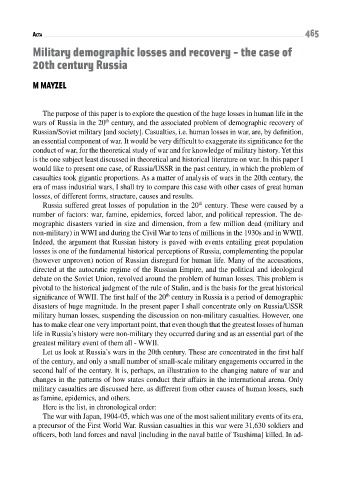Page 465 - Conflitti Militari e Popolazioni Civili - Tomo I
P. 465
465
aCta
Military demographic losses and recovery - the case of
20th century Russia
M MAYzEL
The purpose of this paper is to explore the question of the huge losses in human life in the
th
wars of Russia in the 20 century, and the associated problem of demographic recovery of
Russian/Soviet military [and society]. Casualties, i.e. human losses in war, are, by definition,
an essential component of war. It would be very difficult to exaggerate its significance for the
conduct of war, for the theoretical study of war and for knowledge of military history. Yet this
is the one subject least discussed in theoretical and historical literature on war. in this paper i
would like to present one case, of Russia/USSR in the past century, in which the problem of
casualties took gigantic proportions. As a matter of analysis of wars in the 20th century, the
era of mass industrial wars, I shall try to compare this case with other cases of great human
losses, of different forms, structure, causes and results.
Russia suffered great losses of population in the 20 century. These were caused by a
th
number of factors: war, famine, epidemics, forced labor, and political repression. The de-
mographic disasters varied in size and dimension, from a few million dead (military and
non-military) in WWI and during the Civil War to tens of millions in the 1930s and in WWII.
Indeed, the argument that Russian history is paved with events entailing great population
losses is one of the fundamental historical perceptions of Russia, complementing the popular
(however unproven) notion of Russian disregard for human life. Many of the accusations,
directed at the autocratic regime of the Russian Empire, and the political and ideological
debate on the Soviet Union, revolved around the problem of human losses. This problem is
pivotal to the historical judgment of the rule of Stalin, and is the basis for the great historical
th
significance of WWII. The first half of the 20 century in Russia is a period of demographic
disasters of huge magnitude. In the present paper I shall concentrate only on Russia/USSR
military human losses, suspending the discussion on non-military casualties. However, one
has to make clear one very important point, that even though that the greatest losses of human
life in Russia’s history were non-military they occurred during and as an essential part of the
greatest military event of them all - WWII.
Let us look at Russia’s wars in the 20th century. These are concentrated in the first half
of the century, and only a small number of small-scale military engagements occurred in the
second half of the century. It is, perhaps, an illustration to the changing nature of war and
changes in the patterns of how states conduct their affairs in the international arena. Only
military casualties are discussed here, as different from other causes of human losses, such
as famine, epidemics, and others.
Here is the list, in chronological order:
The war with Japan, 1904-05, which was one of the most salient military events of its era,
a precursor of the First World War. Russian casualties in this war were 31,630 soldiers and
officers, both land forces and naval [including in the naval battle of Tsushima] killed. In ad-

